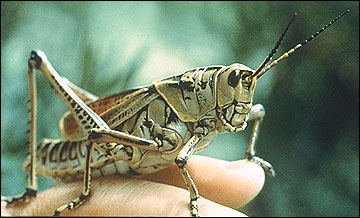
Grasshoppers are relatively large insects, capable of doing considerable damage to many crops. In early summer, grasshoppers normally feed on grasses and weeds in non-crop areas, and later in the season, they move into fields. Grasshopper populations in Missouri are sporadic. In general, damage to crops is most severe in dry years.
Description
Grasshoppers are brown, green or gray insects that may be as long as 1-3/4 inches. They have large hind legs for jumping and prominent heads with large eyes. Adult grasshoppers have two pairs of wings. The front pair is characteristically narrow and leathery, whereas the hind wings are thinner and more triangular. Although more than 100 species of grasshoppers occur in Missouri, four species are responsible for most crop damage. The large differential grasshopper and the redlegged grasshopper appear to be the most common pests, while the two-striped and migratory grasshoppers also occasionally cause problems.
Life cycle
Grasshoppers usually lay eggs in uncultivated soil in areas such as ditch banks, field margins and roadsides, as well as pastures, alfalfa and clover fields. Two-striped and differential grasshoppers lay their eggs near the roots of bunch grasses or alfalfa crowns covered with debris. These sites are usually along field edges or roadsides. Some species lay their eggs in specific bed areas.
Most kinds of grasshoppers lay eggs during late summer or early fall in pods of 20 to 100 eggs. One female grasshopper may deposit 8 to 25 egg pods. Generally, the eggs pass the winter, but in some instances, eggs may hatch and the emerging nymphs overwinter. Eggs hatch from May to June and, as the food source becomes scarce, the nymphs move to nearby fields. In drought-stressed fields, border vegetation is less abundant or dried out, causing nymphs to move quickly and in higher numbers into crops. Once in the field, grasshoppers may do serious damage to the forage crop or pasture. In Missouri, there is usually one generation per year, except for the migratory grasshopper, which has two.
Young nymphs are quite susceptible to weather and natural enemies. Cool, wet conditions during egg hatch reduce grasshopper numbers.
Damage
Typically, grasshopper damage consists of large, irregular holes extending from the margin to the center of the leaf. The growing tips of alfalfa and other plants may also be injured. Grasshoppers are capable of doing considerable damage in a very short time.
Control
The key to effective control of grasshoppers is early detection of the problem. Grasshopper nymphs are easier to kill, partly because of their small size and also because they are usually confined to the hatching area. Do not mow grass along field margins where high populations are found until grasshoppers are controlled. Mowing these feeding sites causes grasshoppers to move into adjacent crops.
In general, control is justified if 3 to 7 or more grasshoppers per square yard are present in alfalfa and clover fields or if 11 to 20 or more grasshoppers per square yard are present in pasture, range or non-crop lands. Keep in mind that the time of day, temperature and vegetation can influence the grasshopper's activity and can affect the number you find.
Consult your local extension office for management options.
Original author: Wayne C. Bailey